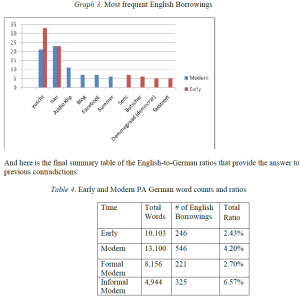Michael Taylor and Dr. Laura Catharine Smith
My research began as I came across contradicting theories concerning the Anglicization of Pennsylvania German while writing a paper for an advanced modern German course. While researching for that preliminary paper, I found scholars suggesting that English has completely taken over the PA German language. Such scholars stated that the rate of English borrowings was increasing at a record rate and that the language was not an actual language at all, but rather a messy conglomeration of English and Standard German. On the other hand, a handful of scholars argued that such research against PA German individuality had been highly exaggerated and that the rate of English borrowings remained much less frequent than such previous scholars had suggested. This contradiction sent me on a journey to gain some sense of closure to this still wide open argument. Basically, I sought out to find an answer to the core question: “How has the rate of English borrowings changed—increased or decreased—over the past ca. 100 years?”
To begin this curious journey, I began by collecting a 10,000+ word textual sampling of early PA German (late 1800s – early 1900s). Of this sampling of poetry, prose, and personal letters, I then dissected each text separately, pulling out any form of English—direct borrowing, hybridization, and/or variant spellings—in order to calculate a total English-to-German ratio. From this early sample, I first discovered evidence to defeat the argument that PA German is not its own distinct language. I found that PA German had developed its own grammatical structures and lexicon unique to both English and Standard German. I also found the total ratio of English borrowings to be 2.43%. This percentage was much lower than that suggested by previous scholars, but to really determine the Anglicization of PA German, I decided to carry my research forward to compare modern PA German to Early PA German.
So, again I began with a sample of modern PA German. I again gathered 10,000+ words of modern PA German all from online sources including monthly newsletters, weblogs, Wikipedia, and Facebook. However, with this sample, I split it once more into formal modern PA German —newsletters—and informal modern PA German—weblogs, Wikipedia, and Facebook. I again dissected the two categories of this sampling to mainly determine the overall ratio of English borrowings. Within the modern PA German, the total ratio of English borrowings was 4.20%. This means that the total increase of English borrowings within the PA German language was 1.77%. Such a minute percentage increase does in no way suggest that the PA German language has been overrun by English or that the PA German speakers have lazily allowed themselves to forget their native tongue and passively slip into English.
These ratios suggest that over the past ca. 100 years, the PA German language has only become 1.77% more English, which brings the previous contradiction another giant step closer to a solution. My study proves that past research that suggested that PA German has been violently anglicized was indeed an exaggeration. This is not to say that past researchers purposely altered their data to support their initial hypotheses, but rather that with modern technology we are able to collect more holistic linguistic samples to study the language as a whole instead of within a single community or single literary genre. Throughout my research, I also developed a respectful relationship with the Pennsylvania German Society and have submitted my final capstone paper for hopeful publishing in one of their PA German Society journals or periodicals. I also made acquaintances with PA German scholars from Pennsylvania State University and a renowned scholar from Germany. They were all eager to help me with my study and provided pivotal leads to further my research.
Here is a summary graph of the comparison of English and Modern PA German English borrowings with samples of the actual borrowings:

